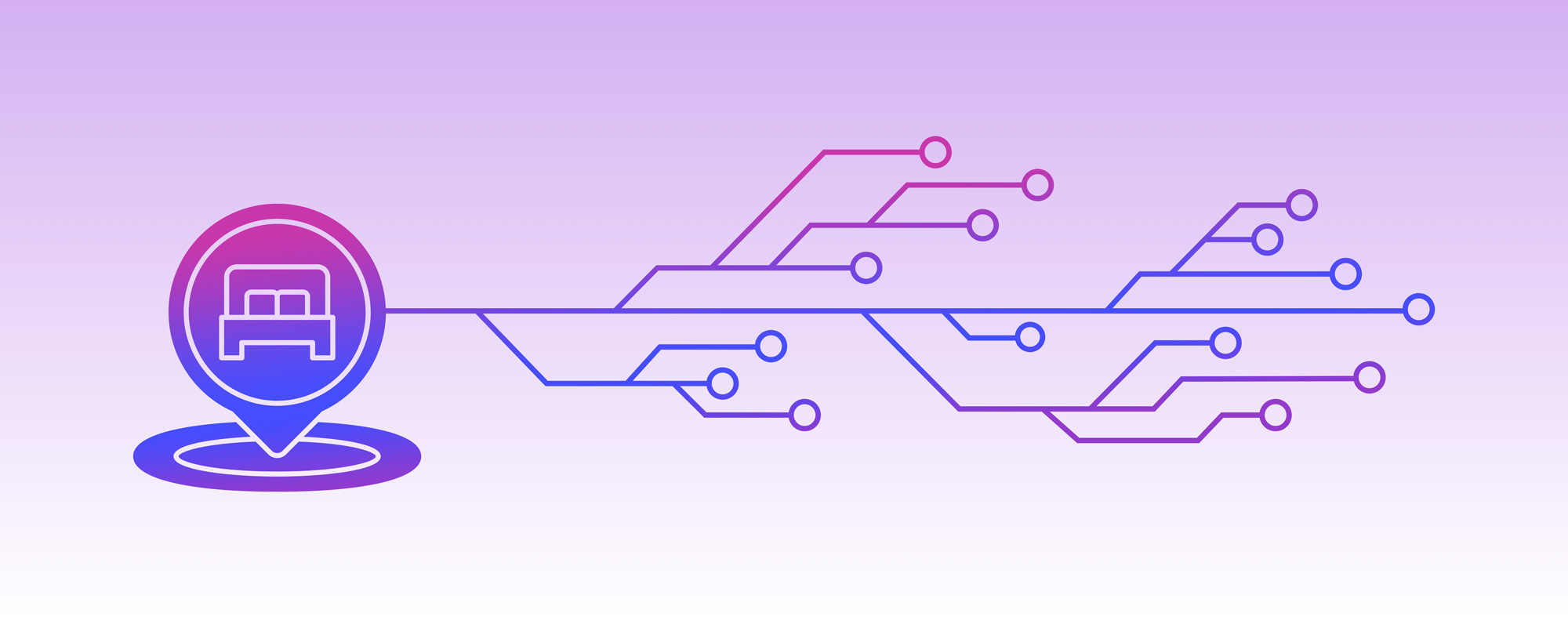Properly executed hotel mapping can be the difference between an online travel business being profitable or not. Learn how hotel mapping can be done correctly.
The global online travel market hit a staggering $433.2 billion in 2021 and is projected to surpass $690 billion by 2026. Online sales dominate the sales distribution with 65% of all tourism and travel sales being made online in 2020. This number is expected to hit 72% by 2025.
With the increase in online sales comes the greater introduction of hotel aggregators, travel hubs, online travel agencies (OTAs), and tour operators. These services have revolutionized the travel industry by offering far cheaper prices than when booked directly. But these changes have not come without their challenges.
The online travel industry suffers from a much higher cart abandonment rate—when people add a product to their carts but fail to check it out—than other industries. A full 53% of these abandonments occurred when the customer was shown the price, indicating that travelers are definitely on the prowl for discounted offerings.
To survive, OTAs and Tour Operators must therefore make all possible efforts to find the lowest possible accurate price for a hotel to have any hopes of competing. In the online world, this effort begins and ends with a subject called hotel mapping.
What is hotel mapping?
To understand hotel mapping, we need to know a bit about how data is stored in a database. Although this is a technical subject, we’re going to cover it simply.
The basics of data storage
Let’s imagine we’re storing data about hotels. We could call the hotel an entity. Every entity (hotel, in this case) has attributes. Some of a hotel’s attributes include:
Hotel ID
Hotel name
Hotel address
City
Country
State
Star rating
Chain
Programmatically, to access data about a hotel, it is only necessary to access its Hotel ID and then lookup the rest.
Different suppliers use different IDs
This looks simple enough. But here’s the problem: Different hotel data suppliers will have different IDs for the same hotel.Let’s imagine our “Hotel Oranges” in Palm Beach. The ID for Hotel Oranges in different supplier databases might look like this:
Supplier A: ID = 123
Supplier B: ID = XYZ
Supplier C: ID = HotOraLA
Supplier D: ID = 9e6b3c7e-930a-4210-aadb-0a17642032da
Supplier E: ID = 456
Because suppliers are essentially competitors of each other, there is little interest in homogenizing the IDs of hotels between their systems. For example, why would Booking.com want to make it easier for you to source data from Expedia? If Booking.com offers more competitive hotel prices, Expedia would lose sales. (We are just using Booking.com and Expedia as hypothetical examples. We don’t know for sure if they behave like this! But the fact remains true in a general way.)
So, what is hotel mapping?
Hotel Mapping is the procedure of mapping the IDs of the same hotel across different suppliers of hotel data so that those IDs correlate with your internal inventory. Doing this also ensures you can provide your customers with the best possible and accurate price. If the procedure sounds simple at a high level, know that it is not simple at all. It is fairly gargantuan and we’ll talk about some of the challenges of hotel mapping solutions in the following sections.
Why is hotel mapping important?
Hotel mapping is essential for being able to provide the best possible price to customers. It is also necessary to have up-to-date data regarding a hotel’s availability so that customers don’t book rooms that are no longer available. There are two scenarios in hotel mapping, each at the opposite end of the spectrum, that can lead to reduced earnings for an OTA or Tour Operator:
False Negatives (failing to match two hotels that actually are the same) result in unrealized potential revenue
False Positives (incorrectly matching two hotels that aren’t actually the same) result in realized losses
Unrealized potential revenue example (false negatives)
Let’s imagine the following scenario for our fictional “Hotel Orange” in Palm Beach:
Source
Source ID
Price
Status
Internal ID
Supplier 1
XYZ
$550
Mapped
123
Supplier 2
ABC
$540
Mapped
123
Supplier 3
A1X
$510
Not Mapped
–
In this scenario, you have three records for the same hotel (“Hotel Orange in Palm Beach.”) but from different suppliers. Your system does not know they are the same hotel until the IDs are mapped to your internal database.
After the procedure, Row 1 and 2 are correctly mapped to the respective hotel in your database, giving you a minimum price of $540 for Hotel Orange in Palm Beach.
Because the $510 record is not mapped to any hotel (a rogue record), you are unable to offer the price of $510 to potential buyers. This False Negative results in potential unrealized revenue because the customer is less likely to book the hotel at the higher price tag if your competitors are offering it at a lower price.
Realized losses example (false positives)
Let’s look at a different example where a hotel is incorrectly mapped. For this example, let’s assume that “Hotel Orange” in record #3 below is actually the Miami Beach hotel instead of the Palm Beach one, and we’re trying to map the Palm Beach one.
Source
Hotel Name
Source ID
Price
Status
Internal ID
Supplier 1
Hotel Orange
XYZ
$550
Mapped
123
Supplier 2
Hotel Orange
ABC
$540
Mapped
123
Supplier 3
Hotel Orange
A1X
$510
Incorrectly Mapped
123
Users hunting for a discounted hotel price for Hotel Orange in Palm Beach on your website will be incorrectly shown the $510 price tag for what your system believes is the Palm Beach hotel. The customer is planning for a big bash for a wedding, can’t believe their luck, and promptly books 20 rooms before the offer expires! (Such good prices can’t be ignored, after all.)
Your OTA is now on the hook for at least $600 ($30 x 20, because the cheapest hotel room for that hotel was $30 more expensive than the one the client booked) for this booking.
The problem is exacerbated when unavailable rooms are “booked,” leading to customer dissatisfaction and bad reviews which can have a snowball effect on future profitability, considering the extremely competitive landscape of the online travel industry.
What are the challenges involved in hotel mapping?
Although hotel mapping is easily understood as a broad concept, the nitty-gritty details of achieving it are quite complex. The following are the primary challenges involved in developing an easy-to-use and accurate hotel mapping solution that eliminates false positives and false negatives.
Precision versus coverage
A badly programmed hotel mapping solution will lead to a higher rate of false positives and false negatives as described above.
Artificial Intelligence and Machine Learning hotel mapping solutions are the best possible solution in this space to reduce these kinds of errors.
User errors can also lead to mismatching. Depending on the hotel mapping solution you’re using, it might be possible to change the settings to favor coverage over precision (leading to potentially more false positives) or precision over coverage (leading to potentially more false negatives).
The problem of precision versus coverage is precisely the problem of potential unrealized revenue versus potential realized losses.
Automatic mapping is incredibly slow
High precision comes at a high computer processing cost, which adds a lot of time.
Two lists of 1,000 hotels would require 1,000,000 comparisons. If each comparison takes a second to execute, this procedure would take 11.57 days to complete! That’s unthinkable in the fast-moving world of online travel bookings.
But it gets worse: It is not uncommon to obtain lists of hundreds of thousands of properties from a supplier. This greatly reduces your competitive advantage and makes maintaining the latest prices a nightmare.
Manual mapping is almost completely useless
Manually mapping is also an option, but it is so slow as to be virtually useless as a viable choice. Some companies opt for a semi-automated solution where their hotel mapping software takes care of what it can within the parameters of precision versus coverage, and then human operators look into unmatched records manually.
Manual intervention is only required to the degree that the AI and Machine Learning features are not efficient enough.
What hotel mapping options currently exist?
There are not too many hotel mapping services available, despite the tremendous need for an excellent hotel mapping tool.
Although different tools exist to map hotel data, none offers the full gamut of requirements necessary to make their tool truly useful. Either they use a slow lookup method of matching IDs, or their API is inaccessible, or their signup process is complicated and doesn’t offer a free tier.
The following table depicts the features available for several unnamed competitors compared with Cupid Travel’s hotel mapping tool.

Only Cupid Travel ticks all the boxes for a completely usable, fast hotel mapping solution.
State-of-the-art hotel mapping with Cupid.travel
Cupid Travel has adopted a revolutionary approach to hotel mapping that addresses the primary pain points for OTAs and Tour Operators when attempting to map hotels to their inventory. Specifically, Cupid Travel’s hotel mapping focuses on:
Extremely high accuracy with minimal false positives
Fully automated solution (because time = money)
To achieve the above, Cupid has leveraged several key elements in the design of our hotel mapping solution:
No Lookup Tables = No properties are missed
The majority of mapping tools available use lookup tables to perform the mapping. This means they have their own “Master Catalog” of properties with their own IDs for each property. When a supplier provides a catalog, the hotel mapping solution attempts to match the supplier’s catalog with their own master catalog. If the property is missing from their master catalog, it becomes rogue and won’t be matched.
It is not unusual for as many as 300 new hotels to open up worldwide in a single month (3,600 new hotels a year). Counting on a lookup-table strategy means your catalog will be missing hotels that your competitors could have.
The problem of a master catalog is particularly egregious for vacation rentals which are virtually impossible to maintain in a master catalog.
Cupid has done away with the Lookup Table approach and communicates directly between the supplier’s data and your inventory data to match hotels. It maintains the highest possible accuracy while doing this because of leveraging AI and advanced Machine Learning techniques.
Completely Automatic
Uploading a CSV file to perform hotel mapping might not be considered cumbersome at first glance, but it quickly becomes so. The rapidly changing travel ecosystem means that data must be updated as often as possible, even daily in some cases.
No OTA is going to be able to manually update a file once a day during peak travel season. There is simply too much to do. And doing it only once a month means you’ll be lagging behind on the latest hotel information.
Cupid completely automates this process.
Instead of manually uploading CSVs, Cupid lets users connect directly to the APIs of their suppliers. This automates the loading of supplier content into Cupid. Then, Cupid can download the data every time a mapping procedure is triggered automatically or via a schedule. This procedure is called upstream.
For downstream automation—getting a mapped CSV file with all IDs mapped into the user’s database—Cupid completely automates this, facilitating automatic download of files into local databases, Amazon storage, FTP, and so on.
All upstream and downstream traffic is automated in Cupid and the user never has to touch it again!
Speed
Cupid’s unique approach to hotel mapping means that it can achieve record speeds for hotel mapping—as little as 5 minutes for catalogs of 100,000 properties! Cupid achieves this through a sophisticated combination of powerful computing resources and advanced artificial intelligence features. The choice to avoid using Lookup Tables also means that processing is made faster because Lookup Table code tends to be slower than more optimized code.
Cupid leverages proprietary technology that ensures efficient computations. We use Google’s Go programming language which is known for its lightning speed. This was also the programming language that Dropbox chose to use for its service, and it did so for the same reason—the Go language’s lightning-fast computing speed.
Hassle-free signup and a perfectly usable free tier
Cupid Travel has made the signup process hassle-free so that any online travel business can get started with hotel mapping in as little as 10 minutes.
Cupid’s free tier is also 100% usable for smaller OTAs and does not expire.
Easy SDKs and APIs
Mapping can be carried out via the intuitive Cupid user interface, or developers can integrate Cupid’s many APIs into their own tool using our wide range of open-source Cupid SDKs (Software Development Kits). These SDKs are currently available in the following languages:
Node JS
PHP
Go
A proper hotel mapping solution = higher revenues
Ensuring that your hotel mapping solution is accurate and has a wide coverage is the best chance you have of making your online travel business competitive in a fiercely competitive landscape.
Ready to start? Sign-up instantly and start mapping in less than 10 minutes at no cost.



